
|

|

|

|
Part of being in a female-male relationship is the opportunity and preference to become pregnant through sex with your partner. Of course female same-sex couples can have children as well, but they are not able to become impregnated through sex with their partner, due to obvious biological reasons. Instead "artificial insemination, in vitro fertilization" (Mader 340), or other alternative forms of impregnation outside of their partner can occur. Despite ones sexuality, reproduction participates in a very strong discourse within our society. I argue that the idea of procreation is particularly strong when it comes to married heterosexual couples. At times you even hear married couples are looked down upon if they choose or are unable to procreate. Intertwined with the discourse of 'the heterosexual female desire of a marital commitment in a female-male relationship,' is the sex journey of a woman. Cosmopolitan magazine, due to the age of its female audience, displays both the recreational and procreational avenues of sexual activity, as well as the appropriate order in which they should occur.
Recreational sex is advertised all throughout Cosmopolitan. Each issue's cover, as displayed on this sites main page, is filled with tag lines such as "The Blended Orgasm" (Oct), "You Sex Goddess!" (Oct), "Be A Sex Genius!" (April), "His #1 Sex Fantasy" (Sept), "Dirty Sexy Sex" (Jan), and "21 Naughty Sex Tips" (March). Recreational sex is seen as quite the opposite of procreational sex, as it is displayed to be adventurous, dirty, and fun. The only fear though is pregnancy! Despite the fact that there in an ever increasing number of individuals contracting STD's, the discourse in Cosmopolitan uses contraceptive advertisements to remind and in some ways calm women's fear of premarital pregnancy. In some cases contraceptives are even an identifier of a worthy man. A Trojan brand condom advertisement (Oct 139) displays a female-male couple in the upper, right quadrant gazing fondly at one another. They are acknowledged by the viewer due to the visibly salient hues upon their skin compared to those hues of the remaining subjects within the advertisement - pigs and unhappy women. The textual anchorage, "choose the one who uses a condom every time" helps to clarify the meaning of this image. Now, as many would agree, pigs have never been considered clean or necessarily desirable animals, but with the tag line at the bottom of the advertisement, it is made clear that the pigs are to symbolize unclean, undesirable, non-condom wearing men. The women next to these pigs/men, look far from pleased. The man who does wear a condom though, is a 'real/human' man, and worth choosing. Once a man is chosen by way of his use of condoms, a woman must take care of her own body. The IUD and birth control pills are advertised as pregnancy blockers. They help the female recreational sex participate have comfort in knowing that she is doing all she can to stay baby free (despite ever mentioning the most full proof alternative - abstinence). By having two medicines that are "99% effective" (Oct 226), as advertised in the birth control ad, and "more than 99 percent effective" (Nov 200), as advertised with the IUD, contraceptives are certainly considered to be the best route to take. What is even more beneficial though to future procreative women, is that when she is ready to move from recreational sex to procreational sex, the IUD can be removed and "fertility will return ASAP" (Nov 200). The discourse and intertextuality between contraceptive ads clarifies that women are not looking to be childless their whole lives, nor are they going to wait until marriage to have sex; they just do not want to become mothers before they have become wives with their diamond ring.
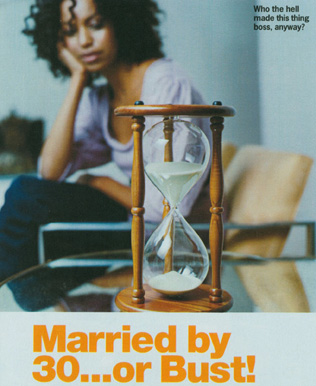
|
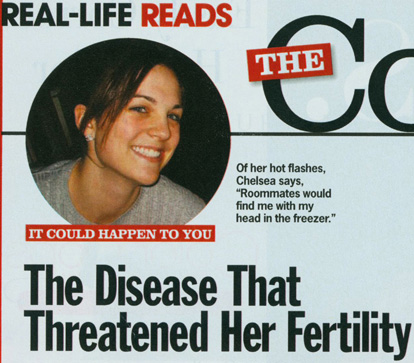
|
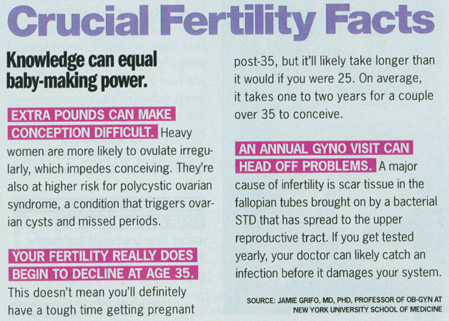
|
At some point in time, women work harder and harder to receive their diamond ring. This comes from the communicated count down that they are nearing the final round of fertility and need to have some spousal prospects in place. Recreational sex cannot go on forever, but instead must become procreational at a certain age, so fear turns from becoming pregnant to a fear of lacking the ability to bear children. One can see this dichotomy in discourse challenging the "Fun - Fearless - Female"-ness of a Cosmopolitan reader, while at the same time strengthening the mythology of the 'heterosexual happy ending'. To make sure women do not get too caught up in being recreational sex participants, articles such as "Married by 30... or Bust" (Oct 140) and "The Disease That Threatened Her Fertility" (Oct 154) exist throughout the magazine's issues. In "Married by 30... or Bust", a photographed hour glass works as a signifier to represent the dissipating time a woman has to procreate. Of course there are many women in their mid-twenties and even thirties who are focusing on their careers, friendships, and other interests, and do not worry about time restraints to childbirth, but Cosmopolitan's discourse works to enhance and normalize characteristics to reflect all 20-something women. It even uses Biopower (transported by the informational clout of a PhD) to communicate that one "Crucial Fertility Fact" is that "your fertility really does begin to decline at age 35" (Jan 181). Once again, with the use of supposed experts, the understanding and trust of a truth claim occurs. The idea that age 35 is too late to have kids, becomes more than just a social myth. The magazine offers additional strategies and tips to their readers if they are one of the 'unfortunate souls' to deal with this dilemma, one being to fight off panic relapses - after all "the relaxed attitude is precisely what attracts guys" (Oct 140). Now, even if one is not nearing the 30 year mark, fertility can still be taken away by disease.
"The Disease That Threatened Her Fertility" (Oct 154) is about a real 22-year old college student who was diagnosed with endometriosis, a disease of the lining of the uterus. In the above excerpt of the article, appellation, or "incorporating [the reader] into" (Rose 100) the ad's world occurs. It begins with the mere fact that the college student falls into the predominant age group of readers depicted within the magazine. More solidifying though is the presence of her snap shot photograph, a rarity among the mounds of studio shots. With the use of an every day, non-airbrushed photo, this college student becomes 'one of the readers'; she becomes a 'you and me' and the reader becomes her. Additionally, her eye contact which is meeting the reader, is demanding the reader to pay attention to her and her story. Though her face is titled a bit to the side and could lead the reader to pay less attention, the caption below her face stating "IT COULD HAPPEN TO YOU" leaves the reader far from dismissing what is at hand. Fear of infertility and the future attainment of the mythology is not just directed to those in their late 20s, but rather is it a constant discourse at play amongst the "21 Naughty Sex Tips" and "Blended Orgasms". Cosmopolitan makes it clear that though recreational sex can and does take place, it is not the finish line. There is a certain route to take, and recreational sex is only the beginning.
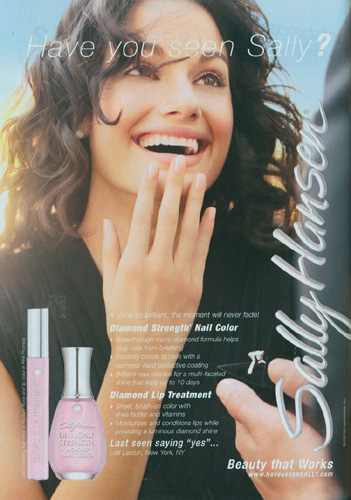 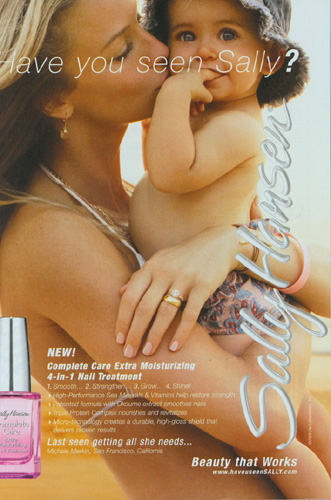
|
The next steps come in the form of a proposal, followed by matrimony and a child. The Sally Hansen advertisements (April 150, 151) explicitly communicate this proper way of navigating. To start off, the two advertisements are spatially located to sequentially tell a story. On the left page the viewer is presented with a woman surprised to see she is being offered a diamond wedding ring. It is assumed that she accepts the offer due to the relationship between her facial expression and the textual anchorage at the bottom of the advertisement, which reads "Last seen saying 'yes'...". It is socially understood that when one asks another to marry them, the response be 'yes' or 'no', therefore this simple statement at the bottom of the page, supports the woman's facial expression to read excitement, as opposed to laughter or happiness for another person's engagement. As the eye follows the images to the right, a new Sally Hansen advertisement appears which depicts a woman with her baby. Centrally located and standing out against the predominantly light-colored skinned background, the woman's wedding band and diamond engagement ring play a large role in understanding the discourse at play. Rose's theory of "visuality" (Rose 3) states the idea that we understand by what we "are allowed" and/or "made to" (Rose 3) see. Due to the location of the woman's hand, and therefore her diamond ring and wedding band, we are made to see that she is a married woman with a child, as opposed to the previous image where the woman was apparently childless and engaged. The difference between the two images as well as the absence of men, is really what creates the discourse in the ads. Biologically, women need men's sperm to create a zygote, but with the absence of men in the images the discourse focuses again solely on the idea of winning the diamond ring and gaining the opportunity to bear children; the men are simply a pawn in the game, a means to an end.
Why must marriage come before pregnancy though? As I hope you can see by now, Cosmopolitan functions very much in the dominant discourse of the greater American society. We see heteronormativity, whiteness, diamond rings, post-marriage pregnancies, and the proper order in which some of these must occur. There are several theories that claim this sequential discourse, but particularly in America I argue the idea of pregnancy after marriage is due to Christian religion. Saving yourself for marriage is a common discourse many children hear as they grow up in the Christian church. Books like Lady in Waiting by Debby Jones and Jackie Kendall and I Kissed Dating Goodbye by Joshua Harris and Rebecca St. James stir up the idea that abstinence before marriage is what 'good girls do'. Personally I feel like these books go a bit overboard at times, but that does not stop their ideas from becoming part of the broader societal discourse. Obviously in Cosmopolitan magazine religion is not discussed, but that does not mean that some social 'norms' that have come from religion do not make their way into the discourse. Instead of 'marriage before sex' though, Cosmopolitan says 'marriage before pregnancy'.